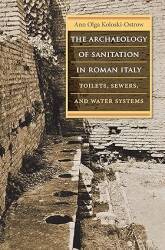
Cloacina, Goddess of the Sewers
Cloacina and the Cloaca Maxima
Cloacina was the Roman goddess of sewers, simultaneously the goddess of filth and the goddess of beauty. She is named for cloaca, the Latin for sewer or drain. Remains of a shrine to her can still be today seen in the Forum in Rome, where she watched over the Cloaca Maxima or the Great Sewer. The Romans, who seem never to have had an original religious thought, picked her up from the Etruscans.
This page has background on Cloacina, and also pictures from a recent visit to Rome in which I tracked down what can be seen of the Cloaca Maxima today.
The Etruscans
The Etruscans lived in what today is northern and central Italy. The ancient Romans called these earlier people the Tusci or Etusci, which is why we call their former heartland Tuscany. The Greeks called them the Τυρρηνοι, which led the Romans to call the sea off the west coast of Italy the Tyrrhenian Sea.
The origins of the Etruscans are mysterious. Their language seems to be an isolate, with speculation all over the place as to its origins and connections — Minoan, Anatolian, Northeast Caucasian, and beyond. Their language influenced Latin, which borrowed a few of its words, but the Etruscan language was completely replaced by Latin. Studies of DNA and mitochondrial DNA have similarly broad results, suggesting Etruscan origins in Anatolia, the Near East, and Central Europe.
Etruscan mythology and religion were incorporated into Roman culture. It was an immanent polytheism, meaning that everything is a manifestation of divine power. That power was embodied in a large number of deities who could be influenced by mortal men. Seneca the Younger compared Etruscan to Roman belief as:
Whereas we believe lightning to be released as a result of the collision of clouds, they believe that the clouds collide so as to release lightning: for as they attribute all to deity, they are led to believe not that things have a meaning insofar as they occur, but rather that they occur because they must have a meaning.
The earliest Etruscan inscriptions date from around 700 BC. The Etruscan civilization was assimilated into the Roman Republic in the late 4th century BC, formally ending with the Roman conquest of Volsinii in 264 BC.
Etruscan legends, and thus Roman ones, held that Rome was founded by Romulus and Remus. Twin sons of Rhea Silvia and Mars, the god of war, they were abandoned at birth, nurtured by a she-wolf, then adopted by a shepherd. They decided to found a city on the Palatine Hill, starting with Etruscan rituals and then getting into a fight in which Romulus killed Remus.
This led to a series of seven kings, starting with Romulus in 753-716 BC. The fifth of these mostly legendary kings was Lucius Tarquinius Priscus, also called Tarquin the Elder. His rule is dated at 616-579 BC.
The Cloaca Maxima
Tarquin is credited with a number of building projects: the Circus Maximus, a stone wall surrounding the city, a temple in honor of Jupiter Optimus Maximus on the Capitoline Hill, and the Cloaca Maxima, the Great Sewer intended to drain the low-lying areas and prevent severe floods of the city.
It was originally an open-air canal running through the main Forum area. It collected water from streams coming down from the surrounding hills and emptied into the Tiber river. It came to be built over and enclosed, and some later sections and branches may have been built by tunneling. See the red line running roughly top to bottom down the center of this map of central Rome during the Imperial period.
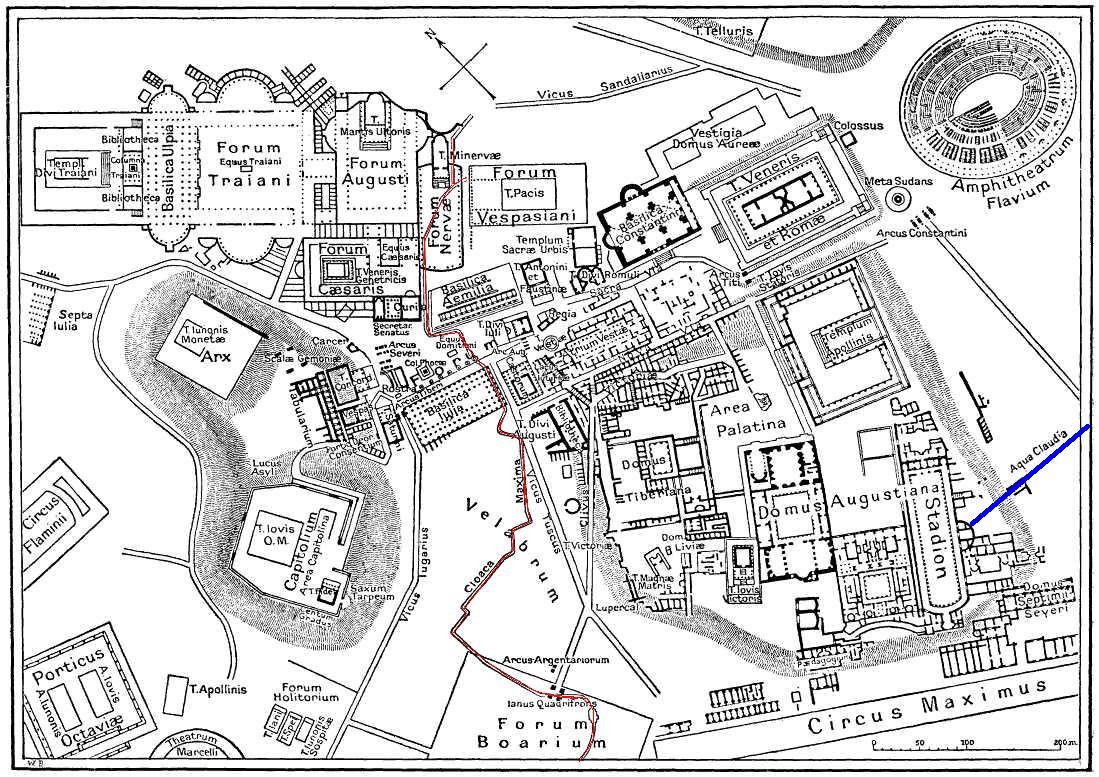
Ovid's Fasti (VI, 401ff.) preserves Roman tradition about the Forum being built in a swamp-like area.
Hoc, ubi nunc fora sunt, udae tenuere paludes,
Amne redundatis fossa madebat aquis...
Qua Velabra solent in Circum decere pompas
Nil praeter salices cassaque canna fuit.
Where now the Forum lies, were pools of water and marshland,
Streams from the Tiber's flood swelled high
the banks of this brook...
Where now through the Velabrum processions move
toward the Circus,
Was nothing but willows
and reeds that shook in the wind.
The Greek geographer and historian Strabo wrote that the sewers of Rome were large enough "for wagons loaded with hay to pass" and for "veritable rivers" to flow through them.
This area has been built up, and re-built, and modified, and so on, over and over and over.
We think that the first sections of the Cloaca Maxima were built around 600 BCE. Now it's 2025, over 2,600 years later. The Romans themselves heavily modified the area, as you can see from the below maps from the Roman Republic era beginning around 509 BCE and the time of the Roman Empire, beginning in 27 CE.

Plan of the Forum area during the Roman Republic era of 509 BCE — 27 CE. From William Shepherd's "Historical Atlas" of 1923, from the Perry-Castañeda Library Map Collection at the University of Texas at Austin.

Plan of the Forum area during the Roman Imperial era of 27 CE through the 4th century CE. From William Shepherd's "Historical Atlas" of 1923, from the Perry-Castañeda Library Map Collection at the University of Texas at Austin.
Rome wasn't sacked in a day, it was a long slow decay instead of a sudden collapse. But the Roman Empire largely disintegrated through the fourth century CE. Romulus Augustus, the rather nominal last Emperor of the Western Roman Empire, was deposed by the barbarian general Odoacer in 476. What had been the center of the world's largest empire became a place for livestock to graze.
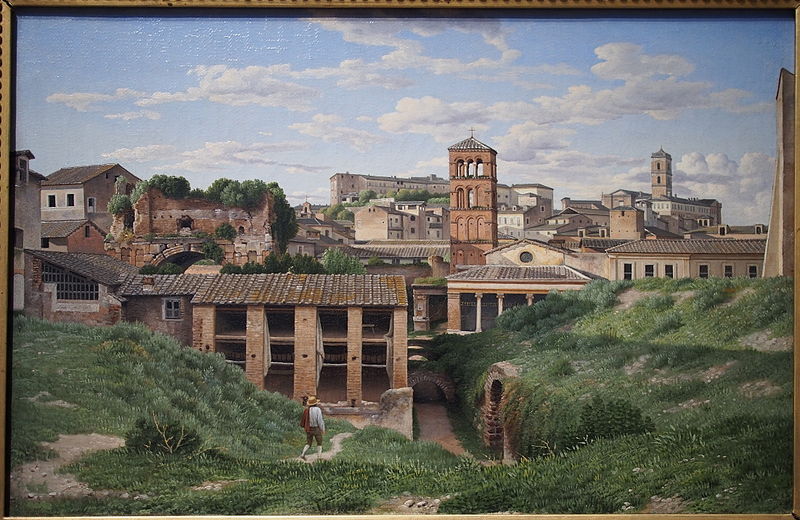
Christoffer Wilhelm Eckersberg 1814 painting showing the Cloaca Maxima, in the U.S. National Gallery of Art collection and on Wikipedia
A real science of archaeology first started appearing in the mid 1700s. Archaeology remains primarily destructive, excavating down through layers and going back in time. Afterward, they can select a layer to reassemble and reconstruct, but how do they decide on which layer to present to visitors?
Cloacina and the Sacrum Cloacina
Cloacina was a goddess, originally Etruscan but adopted by the Romans. She presided over the cloacas or sewers.
Titus Tatius is credited with being a Sabine king who co-ruled with Romulus and who erected a statue honoring Cloacina on the site of the Great Sewer. But... Since the rule of Romulus is traditionally dated to 753-717 BC and that of Lucius Tarquinius Priscus (and thus the sewer's construction) to 616-579, that puts Titus Tatius and his supposed statue about a century ahead of time.
By the time of the Roman Republic, when we had more reliable historians like Pliny the Elder (23-79 AD), the Cloaca Maxima was in operation and Cloacina presided over it. She had come to be identified with Venus, the Roman appropriation of the Greek goddess Aphrodite, or Άφροδίτη. Pliny couldn't explain why the Romans conflated an Etruscan goddess of sewers with a Greek goddess of love, beauty, and pleasure. The Romans cultivated her as the goddess of purity and the goddess of filth. (Literally cultivated, get it? cult-ivated?)
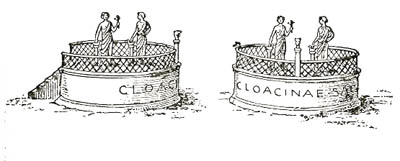
There was a Sacrum Cloacina or Sacellum Cloacinae, the Shrine of Venus of the Sewer, on the Forum. The playwright Plautus mentioned the shrine in the early 2nd century BC, in act 4 scene 1 of his play Curculio. At the time it was on the Via Sacra or Holy Road in front of the Tabernae Novae or New Shops. When those were replaced by an expansion of the Basilica Aemilia in 179 BC, the shrine was probably rebuilt.
Pliny refers to the signa Cloacinae with two statues standing on the shrine. It was described and depicted in The Roman Forum: its History and its Monuments, written in 1909 by Christian Hülsen and Jesse Benedict Carter. 3-5, 136
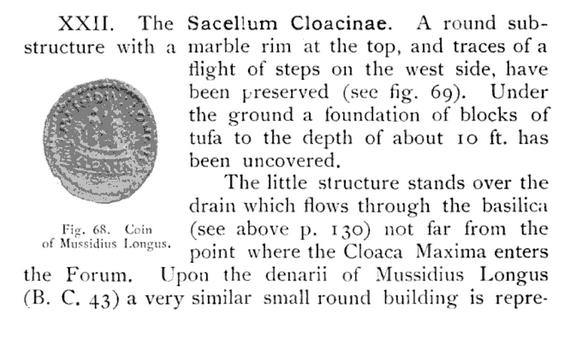
XXII. The Sacellum Cloacinae.
A round substructure with a marble rim at the top,
and traces of a flight of steps on the west side,
have been preserved (see fig. 69).
Under the ground a foundation of blocks of tufa
to the depth of about 10 ft. has been uncovered.
The
little structure stands over the drain which flows
through the basilica (see above p. 130) not far
from the point where the Cloaca Maxima enters
the Forum.
Upon the denarii of Mussidius Longus (B.C. 43)
a very similar small round building is represented,
which according to the inscription is dedicated
to Cloacina.
The so-called 'Parabasis' in the Curculio of Plautus
(see above p. 13) mentions the Cloacinae sacrum
between the Comitium and the Basilica Aemilia;
besides this, its situation is indicated in the
story of the death of Virginia (B.C. 449).
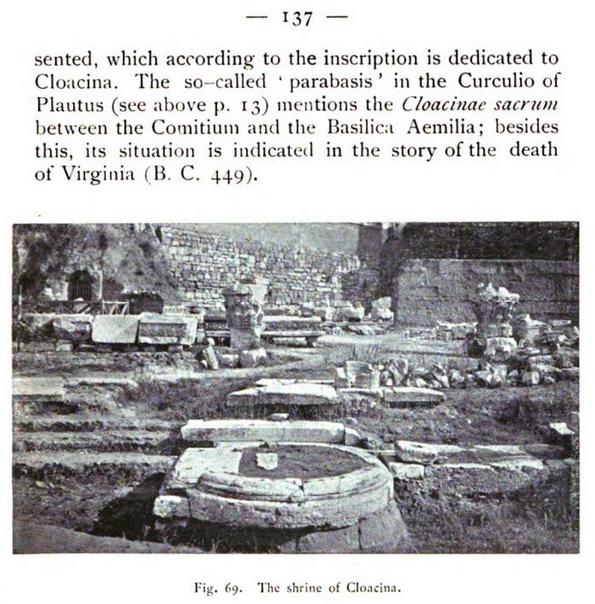
As for what you can see today of Sacrum Cloacina, the Shrine of Venus of the Sewer, keep reading because there are pictures below!
A short poem asking Cloacina to intercede in one's bathroom business is attributed to Lord Byron:
Look on thy suppliants with a smiling face.
Soft, yet cohesive let their offerings flow,
Not rashly swift nor insolently slow.
For another toilet-related deity or demon, see the New Testament Toilets for the Babylonian idea of Šulak, the "Lurker of the Latrine" or the "Demon of the Privy".
Finding Traces of the Cloaca Maxima Today
One of many sources of confusion for today's drain enthusiast is the fact that there were multiple forums during the Roman Republic of 509 BCE — 27 CE, and many more were built during the years of the Empire. Fora and not Forum, you see.
The plan in Shepherd's atlas of 1923, seen above, shows the Cloaca Maxima originating beyond the northeastern end of the Forum of Nerva, adjacent to the Forum of Augustus, which is adjacent to the Forum of Trajan on its other side.
From there it winds around and through what Shepherd follows convention to call the Roman Forum, the one forum out of the many that is somehow the most Roman. It contained the Milliarium Aureum, the Golden Milestone, a column made from or clad in gilded bronze, which represented the point from which all the principle roads of Rome diverged.
Here's the relevant section. The Cloaca Maxima starts near the upper right corner, a short distance beyond the Tomb of Minerva. It curves around that and runs the length of the Forum of Nerva. Then it enters the center of the Roman Forum, where #6 is the Golden Milestone. It turns to its left over 90°, then more gently curves 90° to the right, and runs under the east end of the Basilica Julia, close to the Temple of Castor and Pollux, #14 on this map. Then it runs alongside the curving Vicus Tuscus or Tuscan Street and exits the lower left corner of this small plan.

Keep in mind that basilica is a term of architecture, it does not mean that the structure is a Christian church! It comes from the Greek term, a basilikí stoá or just basilikí, βασιλική στοά or βασιλική. It's a public building following a specific design.
A basilica is a large rectangular public building with two rows of columns dividing a central nave from two side aisles. You enter at the center of one end. Something like a stage would likely be at the far end of the nave. The roofs over the side aisles might be lower than the central roof, with windows between the roof levels providing more light.
The basilica would be some sort of public building, analogous to a local government office building today. Official announcements or other presentations could be made from the stage at the far end. Specific departmental offices would be in the aisles, maybe divided by the columns. It's where you would make a tax payment, where you could get a building permit, and where various local committees could meet and make plans.
It was a useful design. And so, after a few centuries, when Christian churches first began to grow beyond what could meet in someone's home, they started using the basilica design for new church structures.
Meanwhile, naïve Americans go into Google Maps and annotate every local government building they can find in ancient and classical Greek and Roman territory as being Christian churches. I'm sorry, but that's not what those structures were.
Here's a view to the southwest across Trajan's Forum. The tall building made of white marble is the Monument to Victor Emmanuel II. It's a temple honoring Italy's first king after the Risorgimento of 1861–1870 formed a unified nation of Italy, and also the country's First World War soldiers. It was built in stages between 1885 and 1935.

These pictures are from my visit in 2025, when they had recently removed an overhead roadway and were doing further archaeological excavation and restoration. And, tunneling a new subway line and building its nearby stations.

Here is some of the now-re-exposed ground level from Republic and Imperial times. Notice all the drainage! These lines would have fed into the Cloaca Maxima, somewhere off to the upper left of this picture.

Centuries ago, but centuries after the last gasp of the Roman Empire, structures were being haphazardly built above the buried ruins. This is one of the outposts of S.M.O.M. or the Sovereign Military Order of Malta, a crusader outfit that still controls multiple extraterritorial tracts within Rome. File it alongside Freedonia and the Duchy of Grand Fenwick.

See? A S.M.O.M. car! Special license plates and everything. And, it's a classy Romanian Dacia wagon. I have rented and driven Dacias in Romania and France and Iceland. The historical Dacia was a Roman province that became a large chunk of today's Romania, leading to Romanian being the only Latin-based language in eastern Europe. Get it? Roman-ia? But the cars are relatively cheap, and that's probably why S.M.O.M. bought this one.

I went back out to Via dei Fori Imperiali, now the main modern street through the area, and looked back. Those pictures immediately above were taken from that balcony along the S.M.O.M building toward the right.

Crossing the modern-day street of Via dei Fori Imperiali, I could look down into what is perhaps over-simplified as the Roman Forum.

To the left, the Cloaca Maxima comes into view! It's the two large channels just left of center, running off to the right under Via della Curia, a street separating two buildings. The building to the left is Curia Julia, the Roman Senate house built in 44 BCE and still standing today. The much more recent Chiesa dei Santi Luca e Martina Martiri or Church of Saints Luke and Martina the Martyr, is to the right. The first church was built there in 625. What you see today was rebuilt in the 17th century.

However, as you know, we're here for the drains! Two of them! Stacked!

The egg-shaped cross sections of these drains reminds me of the sewers of Paris. The upper one is blocked off and probably filled with rubble. But the lower one can still carry water.

Here is an overhead view from Google Maps. The highlighted point is the site of the Shrine of Venus Cloacina. to its upper left are Curia Julia and the Church of Saints Luke and Martina the Martyr, with the Cloaca Maxima running between them, several meters beneath Via della Curia. As for the shrine, it's very much a "site of". Nothing like the drawing above. It's just a roughly round base of flat stones where a short cylindrical shrine base with two statues once stood.
What remains of the Cloaca Maxima runs well underground from this area to the Tiber river. What you want to do is to walk to where Ponte Palatino, the Palatine Bridge, crosses the Tiber. Go down the staircase to the broad walkway along the river.

Here is the Tiber flowing beneath Ponte Palatino.

The outlet of the Cloaca Maxima into the Tiber is a short distance south of Ponte Palatino.

There's lush growth because water still comes out here.

There's a large diameter opening down in there, a little over two meters in diameter, hidden by all the growth.


Fortuna
The Romans frequently had a small shrine to Fortuna in their latrines. Derived from the Greek Τύχη (or Tyche), whose name literally means "luck", Fortuna's name led from Latin through French to English and our word fortune.
The Romans had plenty to worry about in the latrina — rats and other vermin, swarms of flies, disease, and the always exciting fireball caused by a methane buildup. They could use some good luck, so this was yet another place where a small statue or image of Fortuna was often installed.
However, it was just another devotion for luck, there was no special association of Fortuna and the latrines.
Crepitus
Fortuna wasn't especially connected to sanitation, but at least the Romans believed in her. Crepitus, an alleged Roman god of flatulence, was entirely made up.
Some early Christian writers produced satires of the various minor deities worshipped by those around them. Someone wrote in the Recognitions:
Others [among the Egyptians] teach that intestinal noise ought to be regarded as a god.
The story got out of hand. Tyrannius Rufinus translated the Recognitions from their original Greek into Latin in the late fourth or early fifth century. He spuriously attributed the Greek version it to Clement I, the Bishop of Rome from 88 to 99 AD. (Also see the plumbing of a Mithraeum beneath a church associated with Clement)
Then Robert Burton included Crepitus Ventris or the Flatulence God in a list of classical pagan deities in his 1621 book The Anatomy of Melancholy.
That led to Voltaire listing Deus Crepitus among pagan deities in his 1764 Dictionnaire Philosophique.
Then Baudelaire, of whom more here, got in on the Crepitus game in his 1852 critique of neopagan artists, L'École Païenne.
Finally, Gustave Flaubert made Crepitus a character in his 1849 book The Temptation of Saint Anthony. It references a play by Aristophanes in which the Athenians compare thunder to celestial flatulence. That passage existed in a play by Aristophanes, but that's as close as Crepitus comes to being a classical deity.
